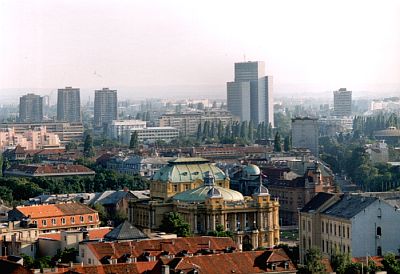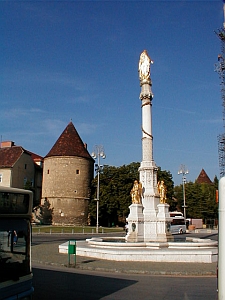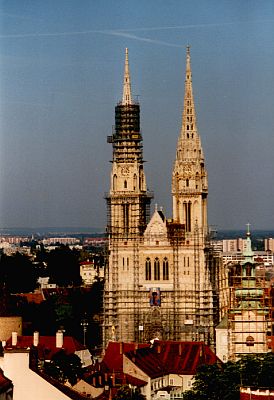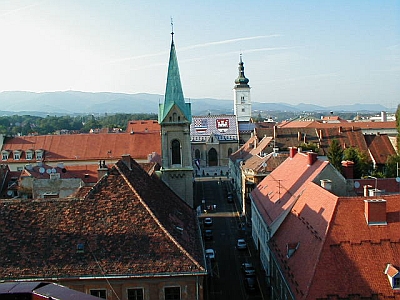Official Name
Zagreb. The old German name Agram can be seen from time to time, too. The name Zagreb derives from the Slavic word za-grebl, which means "behind the ditch". - which depends on the point of view. When you look from the upper town, the lower town stretches along a large ditch. Centuries ago, the town was known as Gradec. Today, this is only the name for the oldest part of the town.
Location

| ||
| Zagreb |
Zagreb is in the middle of Croatia - although it's hard to tell where the middle of Croatia is (geographically, this would be Bosnia...) The town straddles the long Sava (Save) river, but the largest part of town lies north of the river. North of Zagreb, there's the Medvednica mountain range (as far as I know, 'medved' means 'bear'). The highest summit of this mountain range reaches 1,030 metres.
The closest border crossing to →Slovenia is only 25 kilometres away. Slovenia's capital →Ljubljana is 150 km away. The same can be said about the coast.
Population
Almost 780,000 inhabitants (2001) - including the suburbs, the metropolitan area is home to more than 1.2 million people. Thus, Zagreb is by far Croatia's biggest town.
Orientation
Zagreb is clearly divided into upper and lower town. The town stretches from the east to the west, with only a small part occupying the south bank of the river Sava. The historic centre concentrates north of the river. Zagreb's Glavni kolodvor (main train station) lies south of the city centre. From there, two broad roads with excellent parks between them lead northwards. The district around the two roads is refered to as Donji Grad (Lower Town) and features many marvellous buildings from the 19th century. When you keep on walking to the north, you will soon find the large Trg bana Jelačića (Prince Jelacic square). From there it's only a few metres to the oldest part of town called Gornji Grad (Upper Town) and another old district called Kaptol. As the name already says, the Upper Town towers above the rest of the city. It mainly consists of small winding lanes. Since Zagreb is not very big, it's quite easy to orientate. Besides, everything in the centre is within walking distance.

| ||
| Old and new in Croatia's capital |
History
Zagreb is an important town today, but it wasn't always like that. The town was first mentioned in the year 1094 in connection with the foundation of a new diocese. At that time, Zagreb technically consisted of two different towns - one was the rather secular Gradec - today simply called Upper Town - the other one was the ecclesiastical district Kaptol. In 1242, Zagreb respectively the two towns were declared Free Town within the Hungarian empire. In 1557, Zagreb became the capital of Croatia for the first time, but Croatia was not an independent state at that time.
During the 17th century, Jesuits founded a first academy in Zagreb. Later, this academy was turned into a university. In 1776, the Croatian government finally moved from Varaždin (75 km north of Zagreb) to Zagreb, but Croatia remained a province of the Austrian Habsburg monarchy. Nevertheless, the town developed well - culture, industry etc were booming, which can be still seen today.
Zagreb first became the capital of an independent country during the World War II and again after the year 1991. Although Zagreb was many kilometres away from the front line during the war between 1991 to 1995, it was not spared. Occasional air raids hit the capital - no heavy attacks, but still deadly. In spring 1995, minibombs aiming at the life of people were dropped above the old town. Those bombs, so-called 'little bells', wounded and killed several civilians. Furthermore, Serb jet fighters tried to bomb the president's residence and the American embassy.
Today, Croatia is the political, cultural and industrial centre of Croatia. But not the touristic centre. Only few travelers find their way to the capital.
Getting there / transportation
For detailed information on how to get there and away see →Travel information Croatia. There are direct trains from and to Munich (9 hrs), Vienna, several trains a day to →Ljubljana (2½ hours, 87 Kuna), →Split (9 hrs, 91 Kuna), →Budapest, →Belgrade, →Skopje and so on and so forth. All of these and more destinations are also served by buses. Croatia's biggest airport, the Zračna Luka Zagreb, lies around 20 km away from the centre in the south-east. Buses operate between the airport and the centre. There are regular flights from every bigger destination in Europe to Zagreb.
Many visitors start their sightseeing tour from the main train station. The train station is rather disappointing - it's a rather small and slightly drab building (although this might have changed already!) However, as soon as you step out of the building, you will be surprised: A long park, lined by marvellous buildings from around 1900 on both sides, starts right in front of the train station. All of those buildings are perfectly preserved. The first park is called Trg Tomislava (trg=square) and features a large, yellow pavilion used for temporary exhibitions at the end of it. The second park behind the pavilion is the Trg Strossmayerov, which houses the Gallery Strossmayer with new and old masterpieces on display.

| ||
| St Mary Column in Kaptol |
On both sides of the parks, Zagreb's most elegant and expensive boutiques as well as several banks line up. Croatia's top address for business so to say. Another building worth mentioning is the very large Archeological Museum on the left side of the third park, which is called Trg Šubiča Zriskog. When moving direction Upper Town in the north, you will soon enter Trg bana Jelačića (Prince Jelacic square), also known as Republic Square. It's a surprisingly large square, which is often used as a market place. The tourist information faces the square as well.
From Republic Square, it's only a few metres northwards and a short stairway before you enter the Dolac Market (Vegetable Market), which is still used as one by the locals. Here, the district Kaptol starts. As already mentioned above, Kaptol was the ecclesiastical part of the double town Gradec-Kaptol. When walking from the Vegetable Market to the right for a few metres, you will get to another small square, characterized by the St Mary Column in the middle of it.

| ||
| The tall St Stephen's Cathedral |
Opposite the column, there are some remainings of the old fortification system, including two towers from the 16th century. Behind that, the huge Sv. Stpinac Katedrala (St Stephen's Cathedral) towers above the town. The construction of the church with it's two towers was started in the 13th century, but it took around 500 years to complete the project. In 1880, the church was heavily damaged by a tremendous earthquake. And so the church was rebuilt in a neo-gothic style as it can be seen today. The two towers are more than 100 metres high and therefore Zagreb's landmark. Many years ago, the church was renamed 'Cathedral of the Assumption of the Holy Virgin Mary', but the old name 'St Stephen's Cathedral' is still widely used. In 2001, the church was under reconstruction and therefore scaffolding blocked the view. By the time you read this, the reconstruction should have been completed.
When you walk back a few metres and pass the Vegetable Market again westwards, you will get to a long street with the nice name Tkalčićeva. Here, countless bars and cafés line up along the street. The same can be said about near Kozarska ul. (ul.=street), which can be called the night-life district of Zagreb. This doesn't mean that the streets aren't frequented during the daytime as well. Both streets are pedestrian zones and the perfect place for an espresso before entering the Upper Town called Gradec. When coming from Kaptol, the best place to enter the Upper Town is the Kamenita Vrata (Stone Gate). Originally, it was a wooden gate, but it was destroyed by fire in 1731. Legend says that only the painting of the Virgin Mary survived the fire. Today, a small chapel commemorates the incident.
The narrow lanes of the Upper Town are in marked contrast to the spacious Lower Town. Here and there, the Upper Town managed to keep a certain medieval charme. The centre of the Upper Town is called Markovićev Trg (Markov Square). The northern side of the square is dominated by the large Sv. Marko Crkva (St Mark's Church). The roof of the church is a real eyecatcher (see photo below), because Croatia's coat of arms is depicted by colourful tiles. The gothic church was built in the 13th century, but the roof as it can be seen today was added in the year 1880.

| ||
| Upper Town: St Mark's church with its characteristic roof |
Next to the church there's a building called Sabor, which was erected in 1908. Today, it is used by the Croatian National Assembly. Furthermore, there are numerous monasteries, churches and museums, among them the important Hrvatski Povijesni Muzej (Croatian Historic Museum), concentrating in Gradec. In the southern part of the Upper Town and not far from Katarinski Trg (Catherine Square), the Lotršćak Tower provides a good opportunity for having a nice view over Zagreb. The admission fee of 5 Kuna is quite a good investment. From there, it's possible to get back to the Lower Town via a long stairway or by using the more than 100 years old funicular railway.
There's plenty more to see in Zagreb. The nice atmosphere in the centre of town is a real surprise. Additionally, the capital offers a wide range of museums and galleries. Croatia is not limited to Split, Zadar or Dubrovnik and some islands. This is also Croatia.
In 2001, there was a lack of hostels or other comparatively cheap accommodation. And so we took the night train to Split. This might have changed by the time you are reading this. Of course there are many hotels and pensions in town, but don't expect a variety as in →Budapest or even →Prague - Zagreb is substantially less frequented by visitors.
- www.zagreb.hr: The official website of Zagreb city. Contains a lot of interesting information in English and Croatian.
Do you have or do you know a good website about Zagreb? Don't hesitate, let me know! After checking it, I would love to add it to the link list. You can submit a link by using the →contact form. Note that commercial websites will be treated differently.
©2024 Europe-East.com

 Albania
Albania Croatia
Croatia